Physical Address
304 North Cardinal St.
Dorchester Center, MA 02124
In many of the diseases discussed in this chapter the diagnosis is often initially raised on computed tomography (CT) or magnetic resonance imaging (MRI). However, in most cases, it is not possible to make a categorical diagnosis based on the imaging findings alone and it is necessary to correlate with clinical findings and laboratory tests.
In this section we discuss peritoneal diseases that are not classified as infectious diseases or neoplasms. This diverse group of diseases may be categorized as peritoneal fat-based lesions, peritoneal involvement in multiple-organ disease, and fibrosis-related conditions.
Mesenteric panniculitis is an idiopathic condition with mesenteric fatty infiltration, chronic inflammation (with lymphocytes, macrophages), and fibrosis. Fat necrosis and calcification may occur less commonly. The disease is thought to be a continuum of mesenteric lipodystrophy (where fat necrosis predominates), to mesenteric panniculitis (with chronic inflammation), to retractile mesenteritis (where fibrosis predominates).
Mesenteric panniculitis is twice as common in males than in females. The typical manifestation is one of chronic abdominal pain, fever, and weight loss. Alternatively, the patient may be asymptomatic and the finding is seen incidentally on CT. The CT features of mesenteric panniculitis and retractile mesenteritis are listed in Table 82-1 and shown in Figures 82-1 and 82-2 . The differential diagnosis of these conditions is presented in Table 82-2 .
| Computed Tomography Feature | Comment |
|---|---|
| MESENTERIC PANNICULITIS | |
| Increased density of mesenteric fat | Root of mesentery most affected Extension into distal mesentery and retroperitoneum less common |
| Mesenteric vessels encased by increased density fat | No vessel constriction or displacement |
| Scattered soft tissue mesenteric nodules | <10 mm (<5 mm in 80% of cases) |
| “Fat ring” sign | Low-density fat surrounding mesenteric nodules and vessels is seen in >75% of cases; however, not specific and may be seen in mesenteric lymphoma |
| “Pseudocapsule” sign | Thin (<3 mm) capsule seen around expanded misty mesentery in 50% of cases; however, sign not specific and may be seen with liposarcoma |
| RETRACTILE MESENTERITIS | |
| Mesenteric fibrosis | Indrawing and tethering of mesenteric vessels and bowel |
| Bowel ischemia | Seen in severe retractile mesenteritis |
| Disappearance of “fat ring” and “pseudocapsule” signs | When fibrosis becomes more prominent, some features of mesenteric panniculitis disappear |
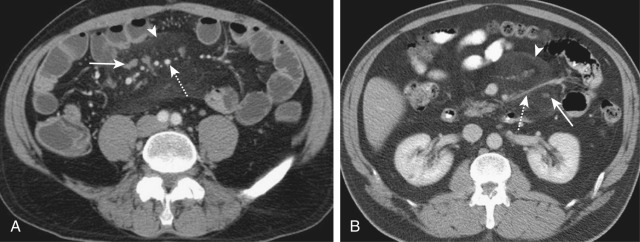
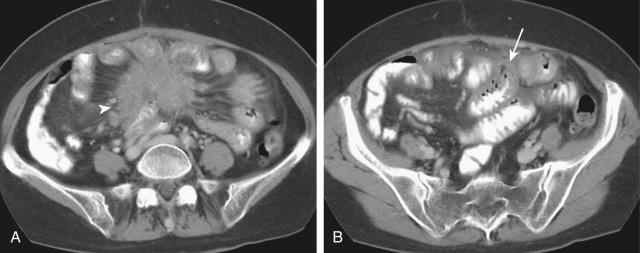
| MESENTERIC PANNICULITIS | |
| Liposarcoma | Unusual CT findings, such as nodules >10 mm, retroperitoneal extension, displacement of vasculature, mass effect, or invasion of bowel and rapid increase in size of nodules on follow-up imaging, require biopsy. |
| Lymphoma | |
| Cushing's syndrome/disease | Variation in fat distribution may be caused by corticosteroid excess, with increased volume of mesenteric fat. Nodules are uncommon in Cushing's disease. Drugs such as lamivudine (Epivir) taken for human immunodeficiency virus infection, may cause increased volume and density of mesenteric fat on CT. |
| RETRACTILE MESENTERITIS (SPICULATED MESENTERIC MASS) | |
| Carcinoid tumor | Biopsy is required if there is no evidence of carcinoid (known tumor, positive on octreotide scan) or tuberculosis (positive cultures). |
| Desmoid tumor | |
| Mesenteric tuberculosis | |
| Peritoneal mesothelioma | |
In some patients (reports range from 1% to 70%), the presence of mesenteric panniculitis is a sign of malignancy elsewhere. In the absence of malignancy, most patients with mesenteric panniculitis have a favorable prognosis and may be managed conservatively with follow-up CT. Experience of specific treatment is limited. Mesenteric panniculitis involving the mesocolon has been suggested to have a more aggressive course, and surgical treatment is often required. Retractile mesenteritis has a poorer prognosis, mainly owing to bowel ischemia.
Epiploic appendices are pedunculated protuberances of adipose tissue arranged in parallel rows along the antimesenteric border of colon. Each appendage is supplied by one or two small arteries from the colonic vasa recta and drained by a single vein. Given the tenuous vascular supply and narrow neck, these appendages are at risk for ischemia or torsion, resulting in inflammation and infarction.
Epiploic appendagitis is usually primary without an associated bowel pathologic process. Uncommonly, it can be secondary to inflammation of adjacent organs (e.g., resulting in appendicitis, cholecystitis, and diverticulitis).
The typical clinical picture of primary epiploic appendagitis is nonspecific lower abdominal pain that usually subsides within 1 week. The pain may worsen with abdominal stretching or coughing. The CT findings of primary epiploic appendagitis are fairly specific ( Figure 82-3 and Table 82-3 ). Because epiploic appendagitis may be secondary to bowel inflammation, it is important to exclude associated appendicitis and diverticulitis before making the diagnosis of primary epiploic appendagitis. Like epiploic appendagitis, segmental omental infarction belongs to the spectrum of fat-based peritoneal and mesenteric conditions. CT findings are shown in Table 82-3 and Figure 82-4 . Differentiation between epiploic appendagitis and segmental omental infarction is not clinically necessary because conservative therapy with analgesics is all that is required for both conditions. Rarely, laparoscopic surgery may be required in persistently symptomatic segmental omental infarction. Infrequently, segmental omental infarction may be mistaken for a fatty tumor such as liposarcoma. The lack of a well-defined outline and typical site of segmental omental infarction, as well as the clinical presentation, usually help differentiate this entities.
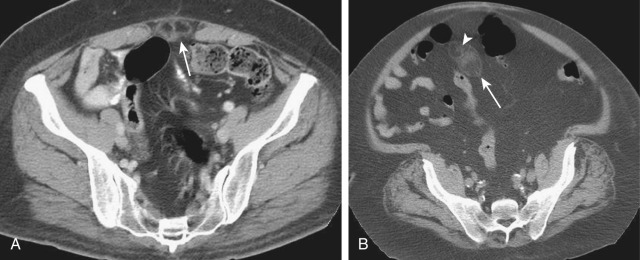
| Computed Tomography Finding Features or Characteristics | Epiploic Appendagitis | Segmental Omental Infarction (see Figure 82-4 ) |
|---|---|---|
| Size | 1-5 cm | Usually 3-15 cm |
| Location | Immediately adjacent to colon | Anterior to transverse colon |
| Shape | Ovoid or clover leaf Hyperdense rim |
Amorphous, no clear outline |
| Side predominance | More common on left | More common on right |
| Mass effect | Nil | May displace transverse colon posteriorly or parietal peritoneum anteriorly |
| Central dot sign : Due to thrombosis of central vein or small hemorrhage | Seen in 50% | Not seen |
| Follow-up scans | Fibrous band or focus of calcification | Often dense calcification and/or fibrosis (see Figure, 82-4, B ) |
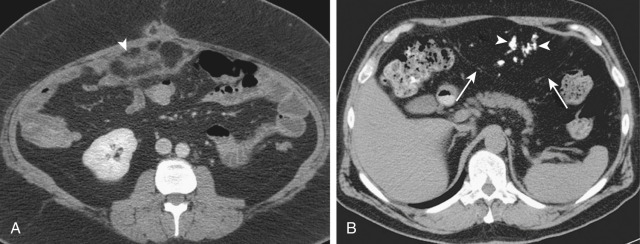
Omental torsion is another cause of acute abdominal pain. It may be idiopathic or secondary to adhesions or tumor. The classic CT sign is a whirling pattern of curvilinear streaks in the omental fat with central hyperdense vascular structure ( Figure 82-5 ). However, the “whirl” sign is not always present, and, if not, differentiation from omental infarction is difficult. It is useful if the diagnosis can be made on CT, because the condition may be treated conservatively.
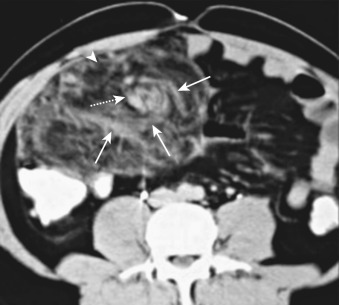
Amyloidosis refers to the extracellular deposition of protein fibrils. Classification of amyloidosis is still evolving. Primary amyloidosis and amyloidosis associated with myeloma show light-chain immunoglobulin deposition (AL type). Amyloidosis associated with chronic dialysis shows immunoglobulin (beta-2 microglobulin) deposition. Amyloidosis secondary to chronic inflammation, such as rheumatoid arthritis, osteomyelitis, and tuberculosis, shows deposition of acute-phase reactant serum amyloid A (AA type). In less common cases of amyloidosis, neuroendocrine peptides such as calcitonin or cytoskeleton proteins such as keratin may be deposited. The CT findings are listed in Table 82-4 .
| Finding | Amyloidosis | Whipple's Disease | Mastocytosis | Sarcoidosis |
|---|---|---|---|---|
| Bowel wall or fold thickening | Bowel involved in 80% of primary, 60% of secondary disease | Seen Sometimes pneumatosis |
Seen in 40%-60% of type 1 disease | Very rare. Gastric wall thickening sometimes seen |
| Lymphadenopathy | Occasionally seen | Low-density adenopathy * | Common in type 3 disease, especially periportal | Upper abdominal and retroperitoneal in 40% |
| Peritoneal thickening | Seen | Seen | Omental thickening | Very rare (20 cases reported) May mimic peritoneal carcinomatosis |
| Ascites | Seen | Seen | Common in types 2 and 3 | Rare; ascites in sarcoid patient more commonly due to cardiac or hepatic disease than to sarcoid |
| Mesenteric calcification | Typically seen | Rare | Rare | Rare |
| Hepatosplenomegaly (HSM) | Seen | Not common | Often seen | 10%-15% have diffuse HSM |
| Specific computed tomography (CT) findings | No specific CT findings | Low-density adenopathy, sacroiliitis | Diffuse or multifocal hot spots on bone scan; sclerotic or lytic bone lesions on CT | Pulmonary involvement in 90% 75% have low-density hepatic lesions and 80% have splenic lesions |
* The differential diagnosis for low-density adenopathy includes testicular cancer (nonseminomatous), treated lymphoma, tuberculosis, and cavitary mesenteric lymph node syndrome. Extramedullary hematopoiesis causes low-density masses that simulate adenopathy.
Although Whipple's disease has an infectious cause, it is typically classed with other infiltrative diseases because its imaging manifestations may overlap. The causative organism is a gram-positive bacillus, Tropheryma whippelii, which is usually found in soil. CT findings are presented in Table 82-4 and shown in Figure 82-6 .

Mycobacterium avium-intracellulare in patients with acquired immunodeficiency syndrome may cause CT findings similar to those of low-density lymphadenopathy and bowel wall thickening. Diagnosis of Whipple's disease is made by small bowel biopsy and demonstration of lipid-laden macrophages containing bacterial fragments that stain with periodic acid–Schiff.
Mastocytosis is a rare disease characterized by excessive proliferation of mast cells in the skin, bone marrow, and other organs.
The 2001 World Health Organization classification of mastocytosis divides this disease into at least five groups. Some groups are associated with hematologic neoplasms or sarcomas. Imaging of systemic mastocytosis includes a skeletal scintigraphic survey and radiographic and endoscopic gastrointestinal evaluation. Bone scintigraphy appears to correlate well with the progression of bone marrow disease in systemic mastocytosis and may help identify a subgroup of patients with an aggressive clinical course. CT findings are discussed in Table 82-4 and shown in Figure 82-7 .
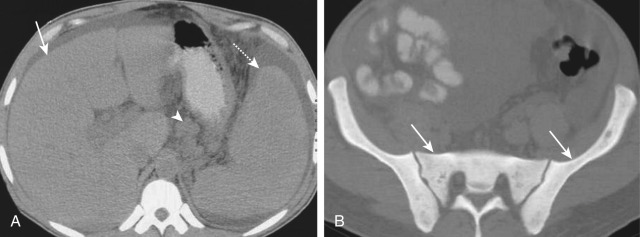
Sarcoidosis is a multisystem disorder of unknown cause characterized by the accumulation of CD4+ T lymphocytes, mononuclear phagocytes, and noncaseating granulomas. Abdominal CT findings are listed in Table 82-4 and shown in Figure 82-8 .
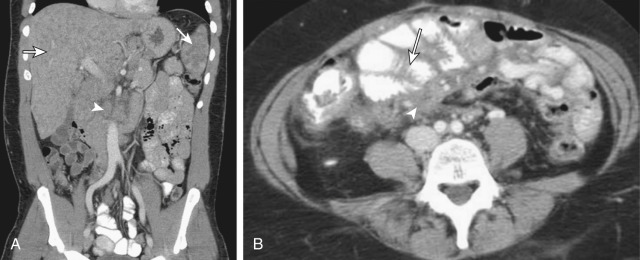
Extramedullary hematopoiesis is an ectopic hematopoiesis that occurs as a compensatory response to insufficient bone marrow hematopoiesis. Although any tissue of mesenchymal origin may show extramedullary hematopoiesis, the liver and spleen are the most common sites in the abdomen. Occasionally, the kidneys may be involved. In such cases, CT shows homogeneously and poorly enhancing perinephric masses that appear to engulf the kidneys without architectural distortion, a finding similar to that in renal lymphoma. Serosal and mesenteric implants may occur, possibly as a result of rupture of hepatosplenic nodules. On CT these implants may be mistaken for lymphadenopathy or metastatic disease ( Figure 82-9 ).
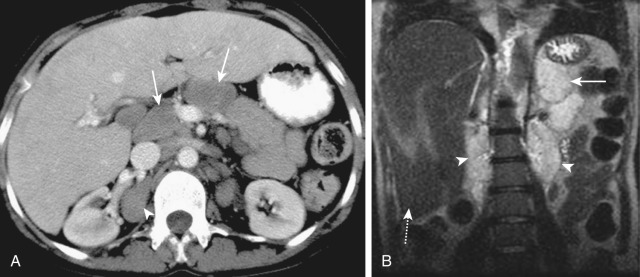
Eosinophilic gastroenteritis is an uncommon disorder with eosinophilic infiltration of different layers of the abdominal gastrointestinal tract.
To make the diagnosis of eosinophilic gastroenteritis it is necessary to have gastrointestinal symptoms, eosinophilic infiltration of the gastrointestinal tract (≥20 eosinophils per high power field), lack of eosinophilic infiltration in other organs, and no evidence to support other conditions associated with eosinophilia, such as drug allergy, parasitic infection, or malignancy. The stomach is the most affected organ in eosinophilic gastroenteritis, followed by the duodenum. The small and large bowels are less commonly affected. Eosinophilic gastroenteritis may be classified into mucosal, muscular, and subserosal subtypes. The mucosal and submucosal forms are discussed elsewhere. The subserosal type manifests as ascites but cannot be diagnosed on imaging studies. Paracentesis usually shows a sterile exudative effusion containing as many as 95% eosinophils.
Become a Clinical Tree membership for Full access and enjoy Unlimited articles
If you are a member. Log in here